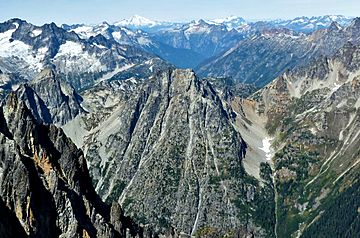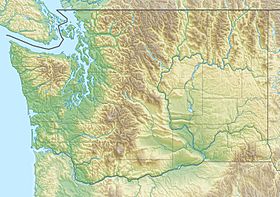Indecision Peak facts for kids
Quick facts for kids Indecision Peak |
|
|---|---|

Indecision Peak (east aspect) in bullseye,
seen from Black Peak |
|
| Highest point | |
| Elevation | 7,945 ft (2,422 m) |
| Prominence | 985 ft (300 m) |
| Isolation | 0.93 mi (1.50 km) |
| Parent peak | Mount Arriva 8,215 ft |
| Geography | |
| Location | North Cascades National Park Chelan County / Skagit County Washington, United States |
| Parent range | North Cascades |
| Topo map | USGS Mount Arriva |
| Climbing | |
| First ascent | 1972 |
| Easiest route | class 4 scrambling |
Indecision Peak is a tall mountain in Washington, United States. It stands 7,945 ft (2,420 m) high and has two main tops, or "summits." You can find it in the beautiful North Cascades National Park. This park is part of the Cascade Range, a long chain of mountains.
Indecision Peak sits right on the border between Chelan County and Skagit County. Even though it's not far from a main road, you can't see it from any highway. Its closest and taller neighbor is Mount Arriva, which is about 0.92 mi (1.48 km) to the north.
The first people to reach the very top of Indecision Peak were Bill Arundell, Frank King, Marilyn and Stan Jensen, and Joanne Williams. They made this exciting climb on August 2, 1972. One of the mountain's lower tops is called Meulefire Peak. It's about 7,930 feet tall. Its name is a mix of "Meulemans" and "Firey," who were the first climbers to reach that specific summit in 1966.
Weather and Climate at Indecision Peak
Indecision Peak is in a special weather zone called a marine west coast climate. This means it gets a lot of moisture from the Pacific Ocean. This type of climate even helps a small glacier form on the northeast side of the peak.
Most of the weather here comes from the Pacific Ocean. It moves northeast towards the Cascade Range. When these weather systems hit the tall mountains, they are forced to rise. This causes them to drop their moisture as rain or snow. This process is called Orographic lift. Because of this, the western side of the North Cascades gets a lot of rain and snow, especially in winter.
The weather here is usually mild. Temperatures rarely go below 0 °F (−18 °C) in winter or above 80 °F (27 °C) in summer. Winters are often cloudy. But in summer, high-pressure systems over the Pacific Ocean bring clear skies. The snow here can be wet and heavy. This means there is a high risk of avalanches, which are dangerous slides of snow. Water from Indecision Peak flows into the Stehekin and Skagit Rivers.
How Indecision Peak Was Formed
The North Cascades mountains, where Indecision Peak is located, have very rugged shapes. You can see sharp peaks, long ridges, and deep valleys carved by glaciers. The amazing landscape you see today was created by powerful geological events that happened millions of years ago. These events caused huge changes in elevation and led to different climates in the area. These climate differences also created many types of plants and animals.
The story of the Cascade Mountains began millions of years ago, during the late Eocene Epoch. At that time, the North American Plate (a huge piece of Earth's crust) was slowly moving over the Pacific Plate. This movement caused many volcanic eruptions. Also, smaller pieces of Earth's crust, called terranes, joined together to form the North Cascades about 50 million years ago.
Later, during the Pleistocene period, which started over two million years ago, glaciers played a big role. These huge sheets of ice moved forward and backward many times. As they moved, they scraped and shaped the land, leaving behind rock and debris. The "U"-shaped valleys you see today were carved by these glaciers. The combination of land being pushed up (called uplift) and cracks forming in the Earth's crust (called faulting), along with glaciation, created the tall peaks and deep valleys of the North Cascades.



